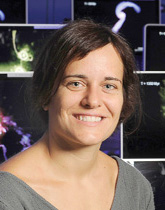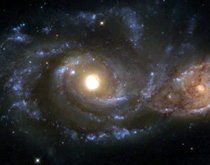
In the Beginning ...
Tiziana Di Matteo reaches across her desk for the can of soda that's partially hidden amid the clutter of papers. It's another late night for the young researcher. The office building at the Max Planck Institute in Munich has emptied out, except for a handful of scientists, including Di Matteo and her collaborator, Volker Springel, working two floors below. There's a conference next month, and she and Springel are putting together presentations.
By this point in her life, Di Matteo has been quite literally around the globe, born in Bologna, schooled in Vancouver, London, and Boston, before coming to Germany. The astrophysicist has always had a fascination with the universe, pondering "the mathematical and physical side of things, the intellectual quest of ‘where does it all come from?'" She started college as an observational astronomer but quickly realized, "Wow, this is boring" and jumped to the theoretical side, using math and computer science to explore the cosmos.
Tonight, Di Matteo has begun to analyze the results of a unique computer simulation she's just completed of two galaxies colliding. Many other researchers have modeled galaxies, but with the use of physics, she is trying to understand the effect of black holes, massive regions with tremendous gravitational pull that are now understood to be at the center of all galaxies. Di Matteo wants to know what role black holes play in galaxy evolution. And why do older galaxies stop creating new blue stars? Why do they turn red and die?
Pushing the soda aside, Di Matteo finishes plugging her numerical results into software that will turn her raw data into what amounts to a mini movie. She stares at the screen, fairly certain what the pictures will reveal—two galaxies merging smoothly into one.

Wrong! As the two galaxies collide on screen, a violent release of gas spews out in a fiery, dramatic display. After comprehending what she just saw, she sprints to Springel's office, practically shouting for him to come upstairs. Tired and groggy, he grudgingly agrees. Staring wide-eyed as the show unfolds again, the generally reserved Springel enthusiastically utters, "Wow!"
Can it be a mistake? They run tests through the night, but the simulation is indeed correct. Di Matteo has discovered that black holes can radiate enough energy and expel enough gas to effectively eliminate the fuel for new blue stars, explaining why older galaxies appear "red and dead."
"This was incredible, absolutely incredible," Di Matteo recalls. "It was the moment I knew this was another step in untangling the origins of the universe. Something big was going on."
Di Matteo, now an associate professor of physics at Carnegie Mellon, presented an overview of her cosmological simulations at last year's annual meeting of the American Association for the Advancement of Science, the world's largest general scientific society. The session was titled, "Big, Small, and Everything in Between: Simulating Our World Using Scientific Computing."
Up next for Di Matteo: How did the universe first become light?
—Melissa Silmore (TPR'85)



